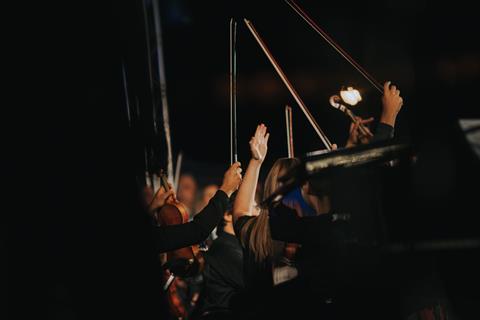While the musicians at the front of an orchestral string section might be in the spotlight, every string player should experience the unique challenges of sitting towards the back, says violinist Alexandra Gorski

Discover more Featured Stories like this in The Strad Playing Hub
Read more premium content for subscribers here
There has long been a false assumption in orchestral string sections that the most demanding roles and greatest challenges in an ensemble reside in the leading positions or front desks. Contrary to common opinion, performing from a position at the back of an orchestra can actually be more difficult than sitting at the front of a section or leading.
All player positions in a string section are demanding, have intricate parts and are integral to the group, yet there are differences between the responsibilities of a section tutti player and those of a leader. Exploring the dynamics of orchestral seating within a string section allows us to shed light on the nuanced difficulties unique to musicians in the rear rows, challenging the conventional belief that the front ranks bear the greatest burden.
Of course, the leaders and the first few desks are in a more visible position within the orchestra, and are more exposed to the conductor (and in most cases, to the audience) both visibly and in their sound projection. Playing orchestral solos, providing clear cues and having direct communication with the conductor and other orchestral sections are all demands unique to sitting in the first few chairs.
Although the rest of the section may not share those same responsibilities, there are separate challenges that are exclusive to those playing in the back desks. When sitting further back in a section, the most evident obstacle is distance: there can be a loss of connection or a feeling of detachment in being far from the section leaders and the conductor. Visibility plays a vital role when performing in an orchestra, and those near the back may have greater difficulty in seeing essential information, like the conductor’s gestures and cues, or the bow distribution and placement of their section leaders.
The strength of a section is not just in its leaders, but in the unity of the whole group
Interpreting the conductor’s directions while contending with limited visibility and detachment from the section leaders forces players at the back to be even more alert and reactive than their front-desk counterparts. In addition to relying on the conductor, those at the back must also depend on their internal pulse, peripheral vision and the cues of fellow musicians to maintain synchroneity within the section.
Then there are the challenges of sound production and balance. Players at the back are positioned more deeply within the orchestra, immersed in a different sonic landscape from those in the more isolated first few stands. They must contend with the projection of all their neighbouring colleagues: woodwind, brass, percussion, a large proportion of other string sections – in other words, an abundance of additional voices. They must navigate through the thicker layers of the sounds around them while achieving a resonant and balanced contribution, not only to their section but also to the collective sound of the ensemble. Orchestral musicians are constantly challenged with alternating between the projection and integration of their sound within the group, and although that can prove problematic from anywhere in an orchestra, it is substantially more difficult when playing near the back.
Observing the different demands of playing in each seat in an orchestra allows players to appreciate that every position, from the first to the final few desks, demands the full engagement and dedication of its musicians. The strength of a section is not just in its leaders, but in the unity and commitment of the whole group, and by exploring the same section from various chairs, orchestral members can become more well-rounded and adept musicians.
Read: Opinion: Flexibility in orchestral playing
Read: Opinion: Are regional differences in orchestral tuning really necessary?
Discover more Featured Stories like this in The Strad Playing Hub
Read more premium content for subscribers here
The number one source for playing and teaching books, guides, CDs, calendars and back issues of the magazine.
In The Best of Technique you’ll discover the top playing tips of the world’s leading string players and teachers. It’s packed full of exercises for students, plus examples from the standard repertoire to show you how to integrate the technique into your playing.
The Strad’s Masterclass series brings together the finest string players with some of the greatest string works ever written. Always one of our most popular sections, Masterclass has been an invaluable aid to aspiring soloists, chamber musicians and string teachers since the 1990s.
American collector David L. Fulton amassed one of the 20th century’s finest collections of stringed instruments. This year’s calendar pays tribute to some of these priceless treasures, including Yehudi Menuhin’s celebrated ‘Lord Wilton’ Guarneri, the Carlo Bergonzi once played by Fritz Kreisler, and four instruments by Antonio Stradivari.













































4 Readers' comments